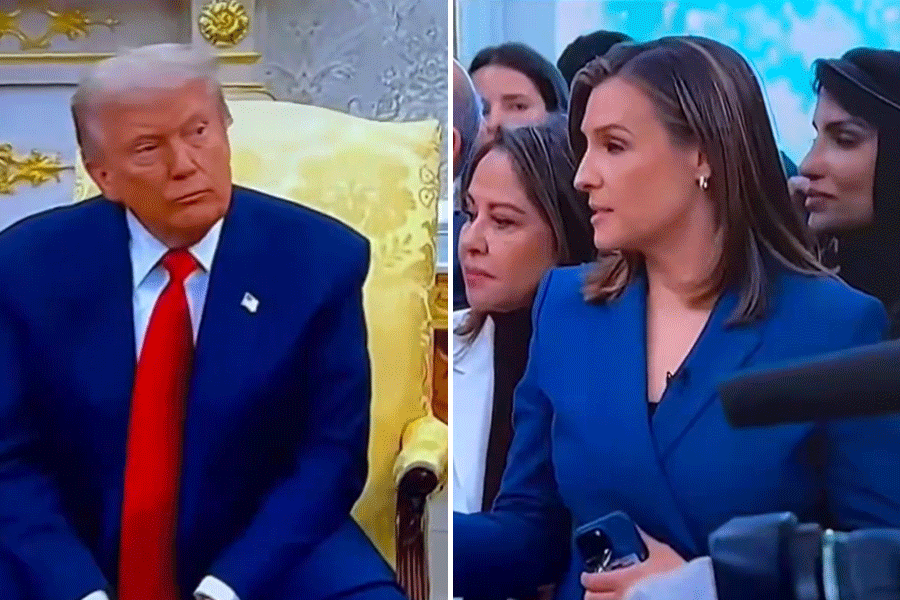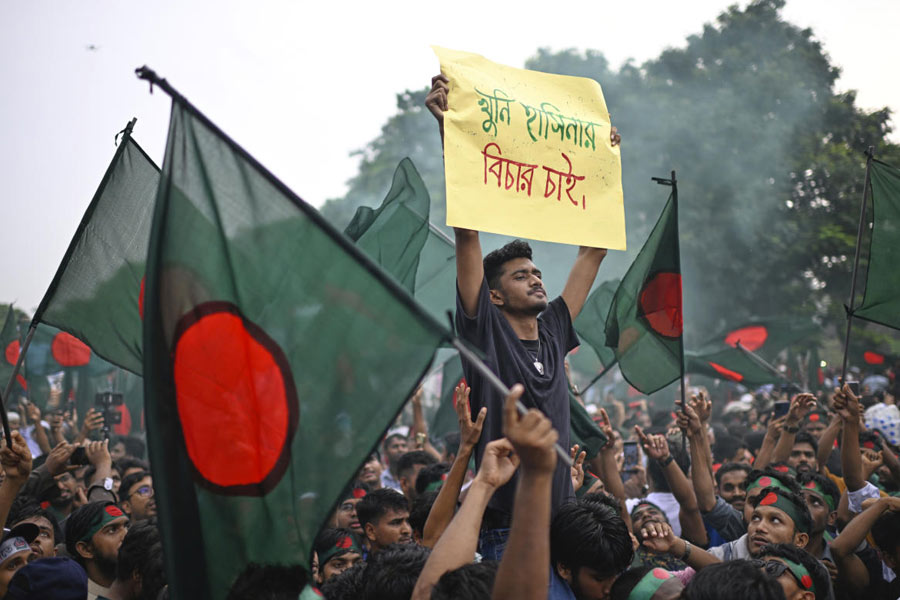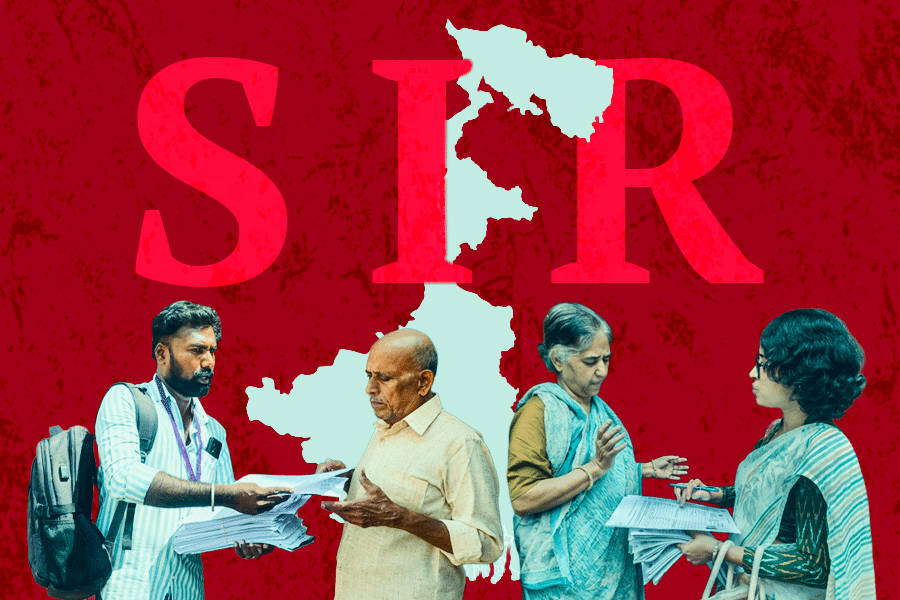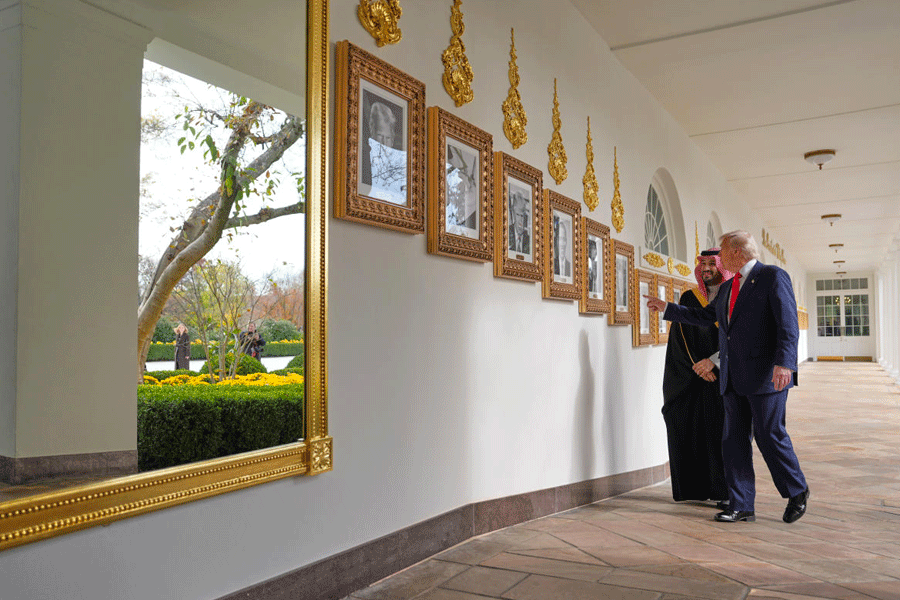
Lalu Prasad with Nitish Kumar in Patna last week. (PTI)
Patna, Oct. 15: Quite often fairly late in the evening, a sparkling SUV emerges from one shuttered bungalow on West Patna's Circular Road and purrs past the open gates of another one slightly up the road. Its sole occupant is most likely to be Prashant Kishor, Nitish Kumar's one-time alliance-averse strategist who has now also made it his job to keep the Nitish-Lalu tandem on swift and even keel.
Kishor is in all probability carrying a missive from Nitish for Lalu's suggestions or approval; shortly enough, the SUV will make the short return journey, a crease straightened, a hump negotiated, Bihar's mahagathbandhan (Grand Alliance) humming in defiance of all predictions of doom.
Nitish and Lalu live two plots apart in a vast acreage of expansively laid out colonial bungalows. This district supplants on the chaos of Patna almost the illusion of Lutyens' Delhi - a silken circuitry of tree-lined avenues, manicured parks, beacon-mounted sedans and security barricades.
For all the time that they have shared this neighbourhood, ties between the Nitish and Lalu homes have never been as proactive or stress-free. For all the to-and-fro of messaging going on now, little is getting lost in translation. One of the reasons could well be that the man picked as runner-mediator between the two has little Bihar baggage.
Prashant Kishor does not come previously invested in the mahagathbandhan's political cast or lineage - socialist, Janata, RJD or JDU. That makes him a man free of local coils.
Kishor was known, initially, to have had reservations about Nitish joining hands with Lalu. This owed primarily to the latter's image liability. Insiders would tell you he was keen on a campaign solely and strongly calibrated around Brand Nitish. But over the past several months, Kishor has moved on, reading the signs, particularly after Prime Minister Narendra Modi hit the ground hard and blistering; he shed doubt, corrected course and began to back the alliance and secure the compact with Lalu. So much so that among peers in the Nitish Kumar establishment, Kishor is often known to be subjected to light-hearted ribbing over having become closer to Lalu than to his own boss.
The ease of doing business Lalu Prasad and Nitish Kumar have achieved is one of the more engrossing narratives unfolding on the sidelines of the Bihar campaign, and impacting its course. In the space of a few months, the two great gladiators of the Bihar stage have gone from bitterness to unease to brotherly bonhomie in a fashion that has taken onlooker and insider alike by surprise.
When they decided to go it together, lieutenants of both leaders were braced for crisis-management; they've been pleasantly taken by how little has been required. Their adversaries have been disappointed Lalu and Nitish have belied predictions of fracture stage after stage.
There were false starts and hiccups, but once Lalu decided to accept Nitish as lead act of the alliance, everything else began to fall smoothly in place - the share of seats, decisions over who contests which, who sacrifices what, how the campaign is structured, who adopts what time and tenor, who takes the offensive, who guards the fort.
Lalu has done most of the attacking and bellicose Mandal constituency-building; Nitish has done the ' bhadralokspeak' with inclusive development as his bedrock. 'Of course there were differences, but we have been able to straighten the creases speedily and without any of that going public,' a key Lalu aide told The Telegraph. 'It was critical to send the message down that the two leaders are working with complete compact.'
Each morning as they set out on their respective trails, they have on their chopper-stop lists a few candidates of the other to canvass for. Most nights, they end up conferring on what to do next, if not directly, through intermediaries. That job is Kishor's to do.
The prime mover of this concord was compulsion. Both read the writing on the wall with equal alarm: divided, they would be swept off a realm they have taken turns to rule for a quarter of a century; united, they still stood a chance of defending it. The fruits of a joint effort became evident to them immediately after the Lok Sabha rout of May 2014, when they took six of the 10 Assembly seats that went to bypolls months later in August.
Even so, there were troublesome corners to negotiate. For two decades, the two were Bihar's most hostile rivals, the sour detritus of prolonged battle lay between them. Modi's lightning charge on Bihar dusted off some of it, but not all. It took months and several hit-and-miss attempts for them to come together.
The Congress, the third and junior alliance partner, played match-maker, reading the riot-act to Lalu and hectoring him to accept Nitish's leadership.
Nitish's part of the bargain? A fair, indeed equal, share of seats, and should you be anxious about securing your sons a political future, have no worries, they'll be taken care of.
Since then, both mahagathbandhan spearheads have conducted themselves with a sameness of purpose that to many appears out of character. Is this a lasting thing? Can they hold out together, this chalk and cheese couple?
Should they win Bihar, another challenge will be upon the two Biharis to meet. Should they lose, the imperatives of working together may turn even more pressing. Surely, this isn't the last election in the lives of either.











